Tender, gelatinous and aromatic, Chinese red braised pork belly is scrumptious and comforting. This recipe shows you how to cook it effortlessly.
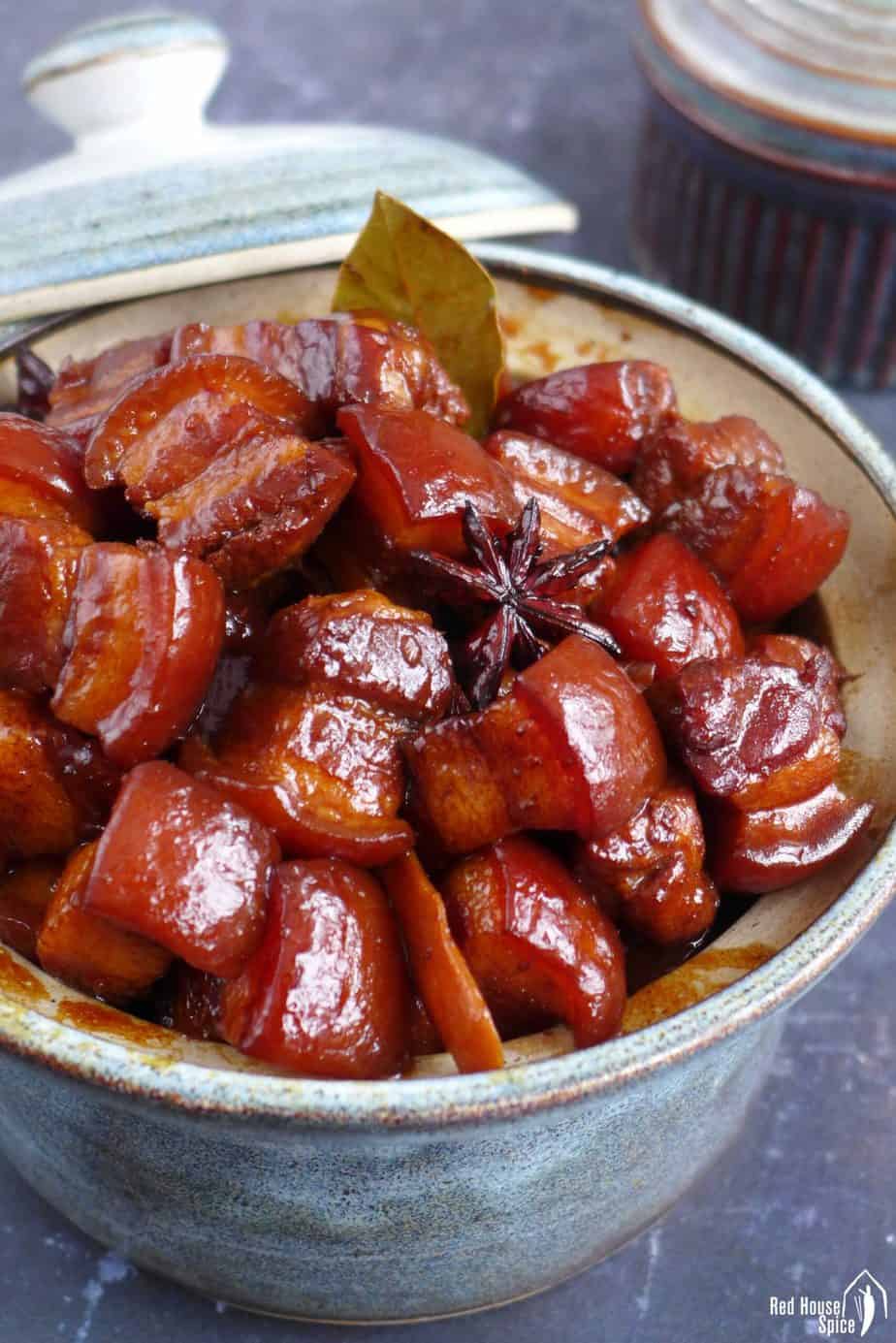
Jump to:
What is Hong Shao Rou
A popular cut of meat, pork belly is treasured by many great cuisines around the world. Containing a high percentage of fat, it needs to be cooked in a particular way to reduce its greasy taste.
In China, the most loved pork belly dish has to be Hong Shao Rou/红烧肉, known in English as red braised pork belly or red-cooked pork belly.
Pork belly chunks are braised with soy sauce, rice wine, sugar and spices to create a complex taste: salty, sweet, aromatic and umami. The skin and fat become gelatinous, not greasy and melt easily in your mouth.
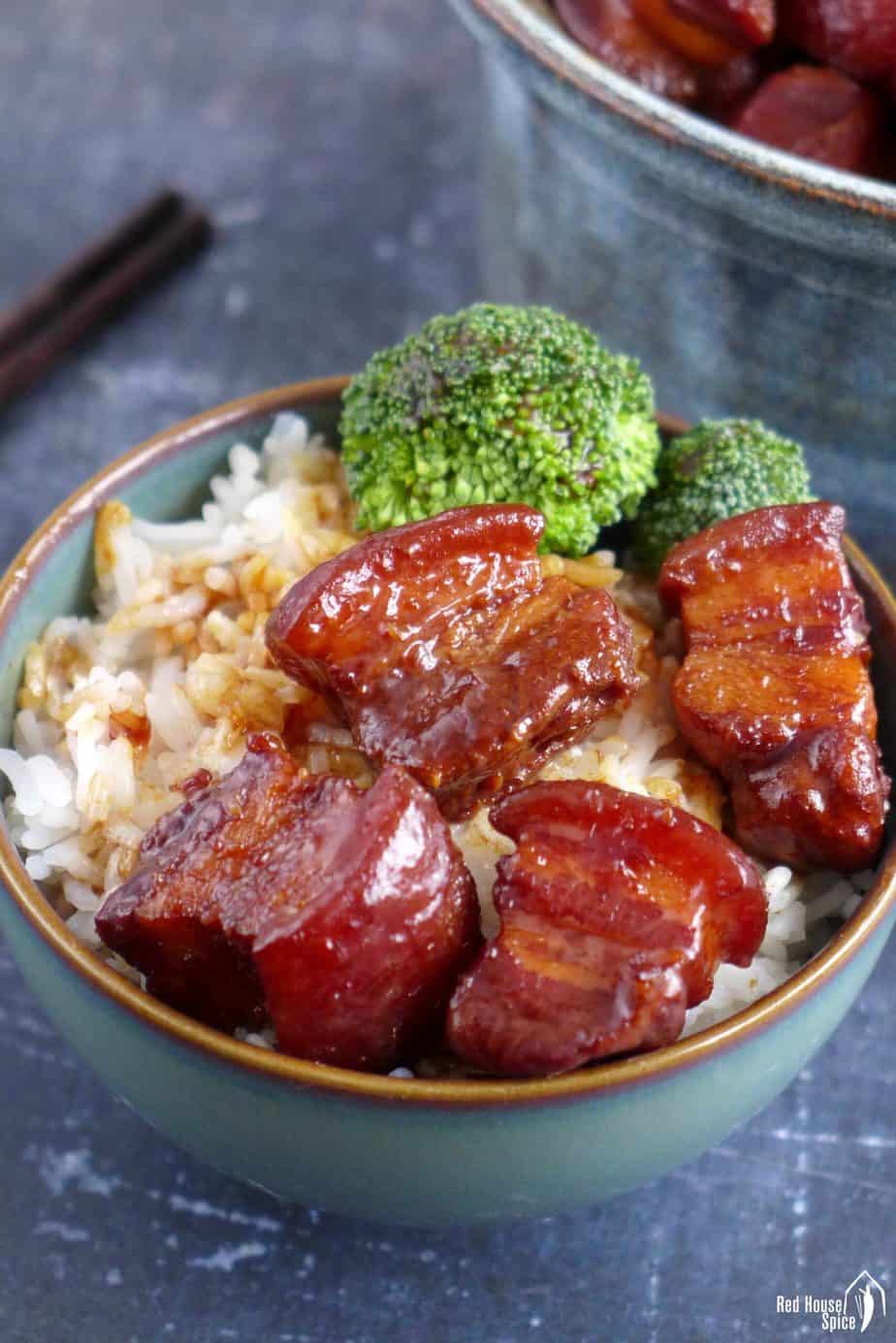
Regional variations
Apart from the desired taste and texture, braised pork belly also stands out for its red-brownish shine. That’s where the word “red” in its name comes from. Among many varieties of this dish from different regional cuisines of China, there are two classic ways to achieve this effect.
The famous Hunan style is believed to have been Chairman Mao’s favourite dish (Hunan was his home province). Rock sugar, in this version, is melted in hot oil to a caramel colour to give the meat an appetising appearance. Another popular variety from Shanghai cuisine involves dark soy sauce which plays a key role in colouring the pork.
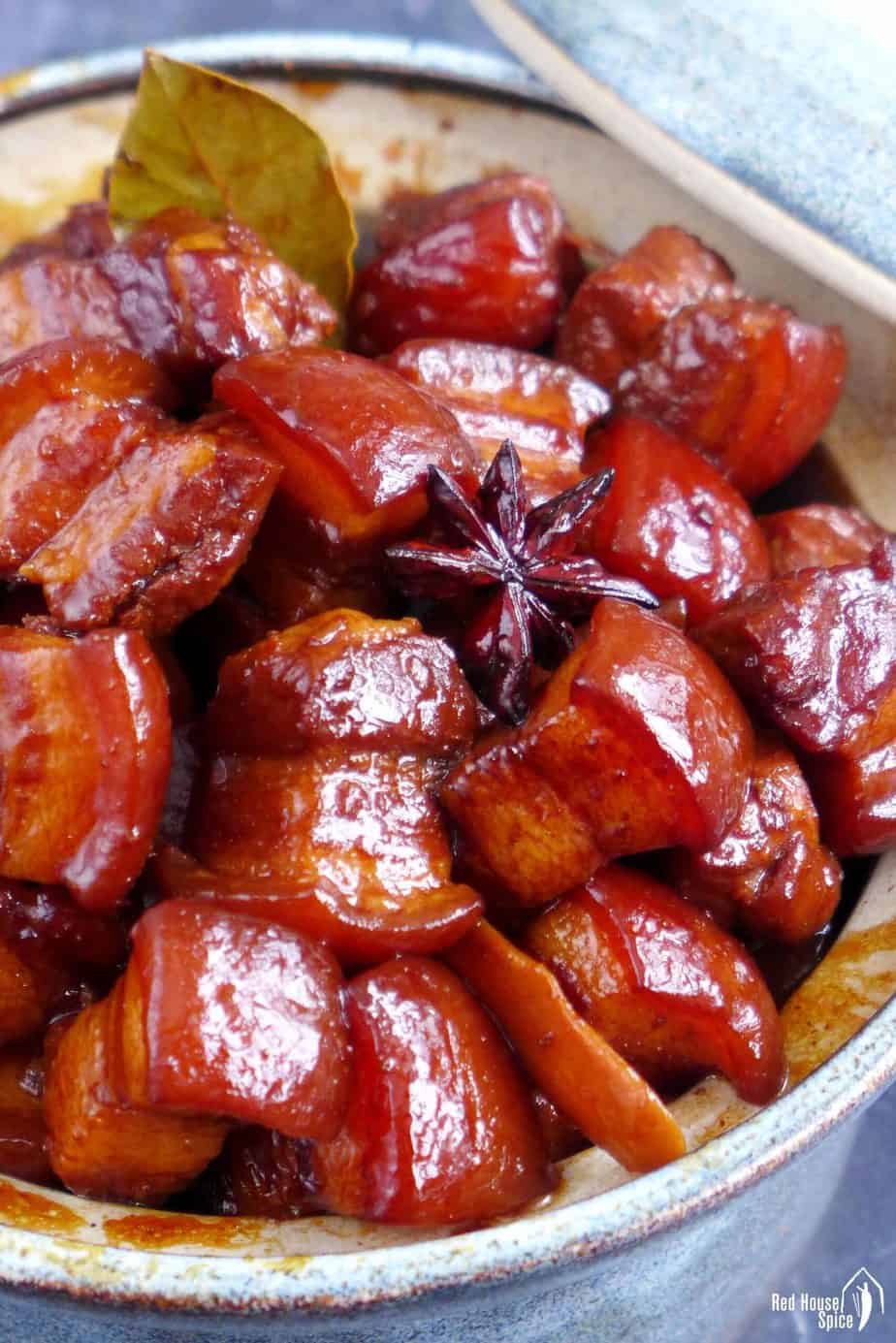
Why this recipe
Over the years, I’ve made braised pork belly numerous times using different seasonings and methods inspired by various versions of this dish. Eventually, I settled down with a recipe that’s super easy, yet delivers a great result.
There is no frying involved (leaving you a greaseless kitchen) thus no extra oil needed (there’s enough fat in the pork belly already). And you don’t have to master the skill of caramelising the sugar properly. Yet the finished dish is more than satisfying. It’s totally novice-friendly. I promise!
Ingredients
The ingredient list is short and simple. Here are some tips on sourcing them that you might find useful.
Pork Belly
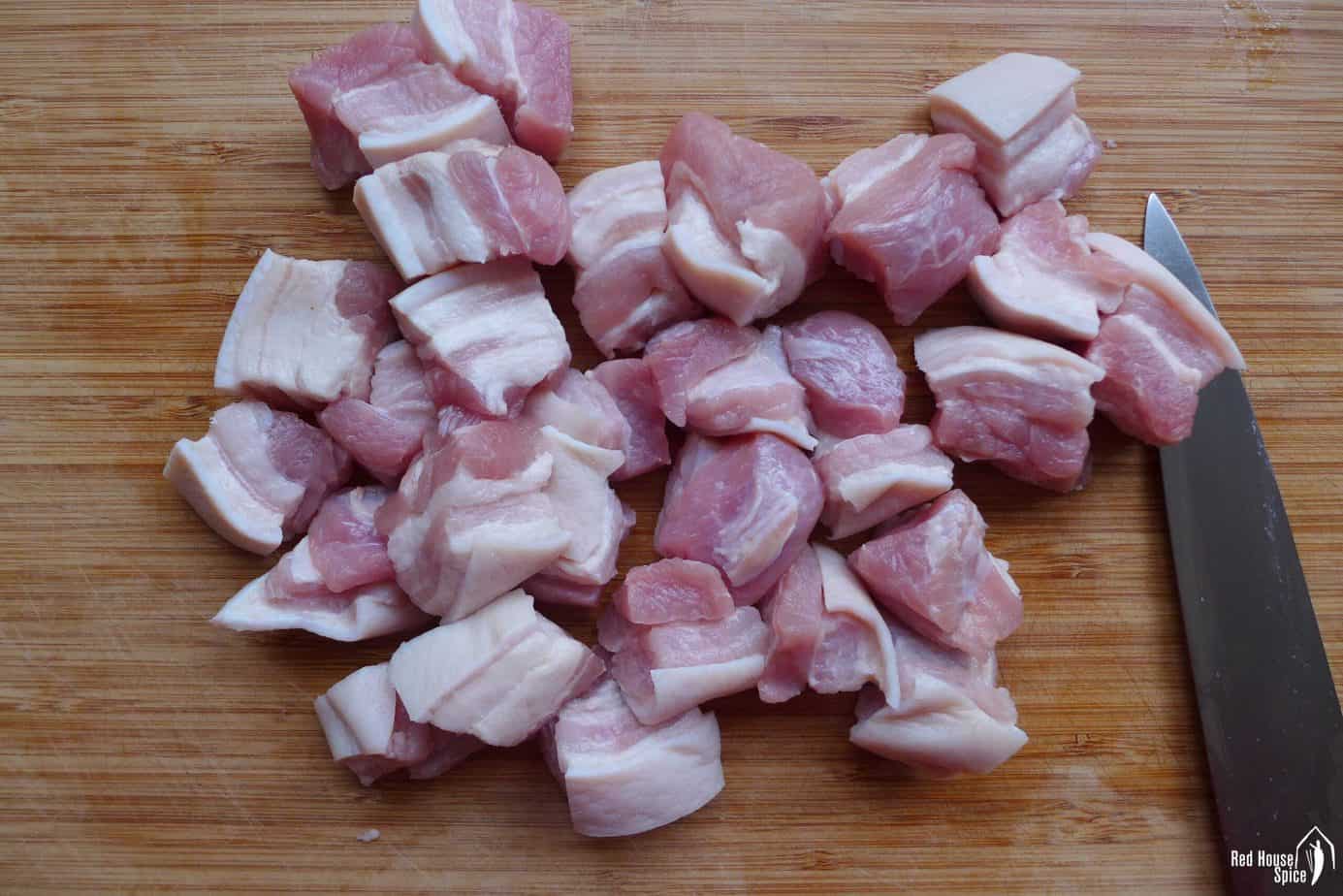
The star ingredient of the dish, pork belly is the fattiest yet the tastiest cut of pork. It’s not recommended to use skinless one. After cooking, the skin becomes super tender and gelatinous. You’ll love it for sure!
I usually cut it into 2-3 cm cubes (about 1 inch). You could use bigger chunks if you wish. Make sure they’re more or less the same size and extend the cooking time if necessary.
Shaoxing Rice Wine
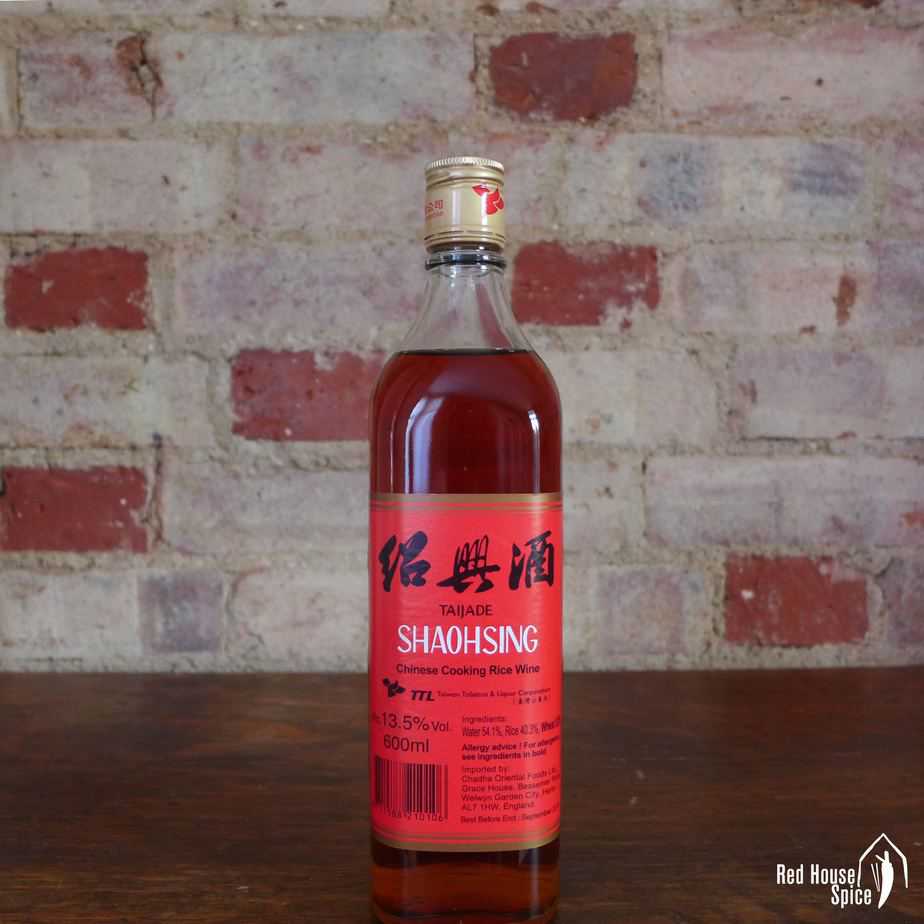
A type of Chinese cooking wine, Shaoxing rice wine (绍兴酒) lends an aromatic, rich flavour to the meat. It also seems to minimize its greasiness. As one of the must-have condiments for authentic Chinese cuisine, it definitely deserves a place in your pantry.
Unlike in many other recipes which call for only a spoonful of Shaoxing rice wine, for this dish I recommend you use at least 250ml (about 1 cup) for 600g (1.3lb) of pork belly. In fact, you could increase the quantity and use only rice wine (without water) as the braising liquid (like how I cook Three Cup Chicken).
🛎 NOTE: The proper Shaoxing rice wine should contain very little salt (mine has 0.08g salt per 100ml wine). However, I’ve seen some versions have a much higher percentage of salt. And they tend to have a bitter, unpleasant taste (usually cheaper to buy). I suggest you avoid those ones (check the nutrition label before purchasing).
Soy Sauce
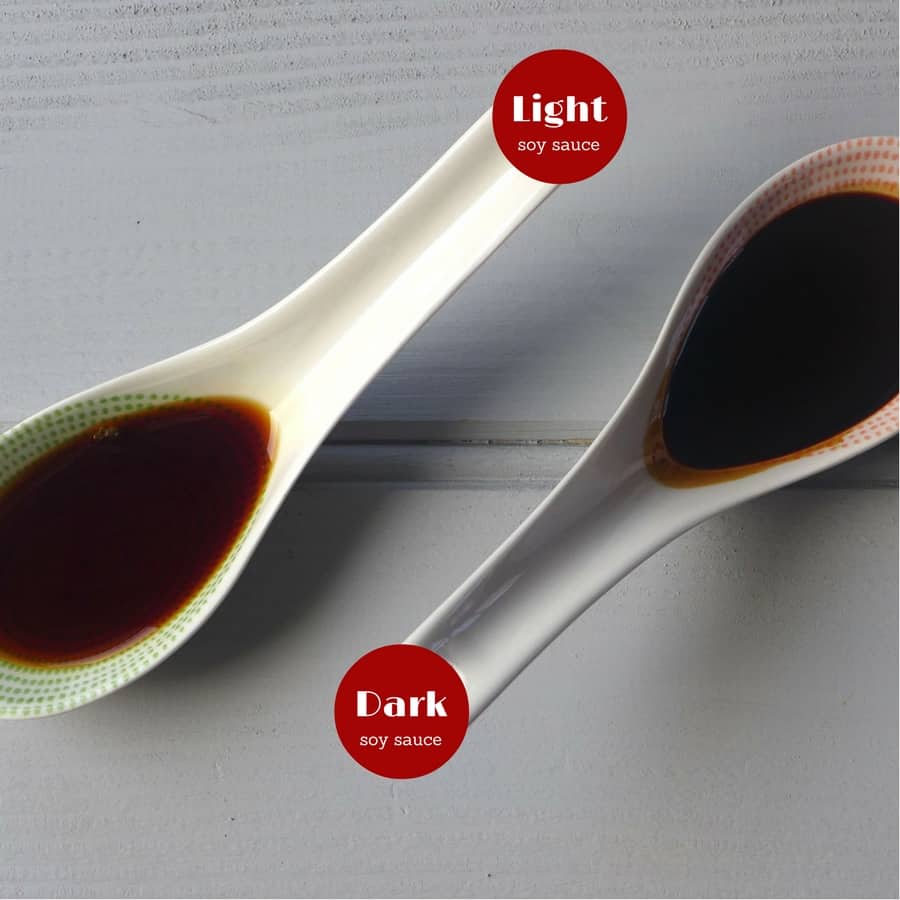
I use two types of soy sauce: light soy sauce (生抽) and dark soy sauce (老抽) for this dish. The former acts like an aromatic salt. The latter, which tastes less salty but offers a caramel overtone, is the key ingredient for giving the pork a beautiful brownish-red shine. So I don’t recommend that you substitute it with regular soy sauce.
Aromatic & Spices
Three simple ingredients, ginger, star-anise and bay leaf, are often found in classic Chinese braised dishes. They help to reduce the gamey taste of the meat as well as enhance its aroma.
Rock Sugar
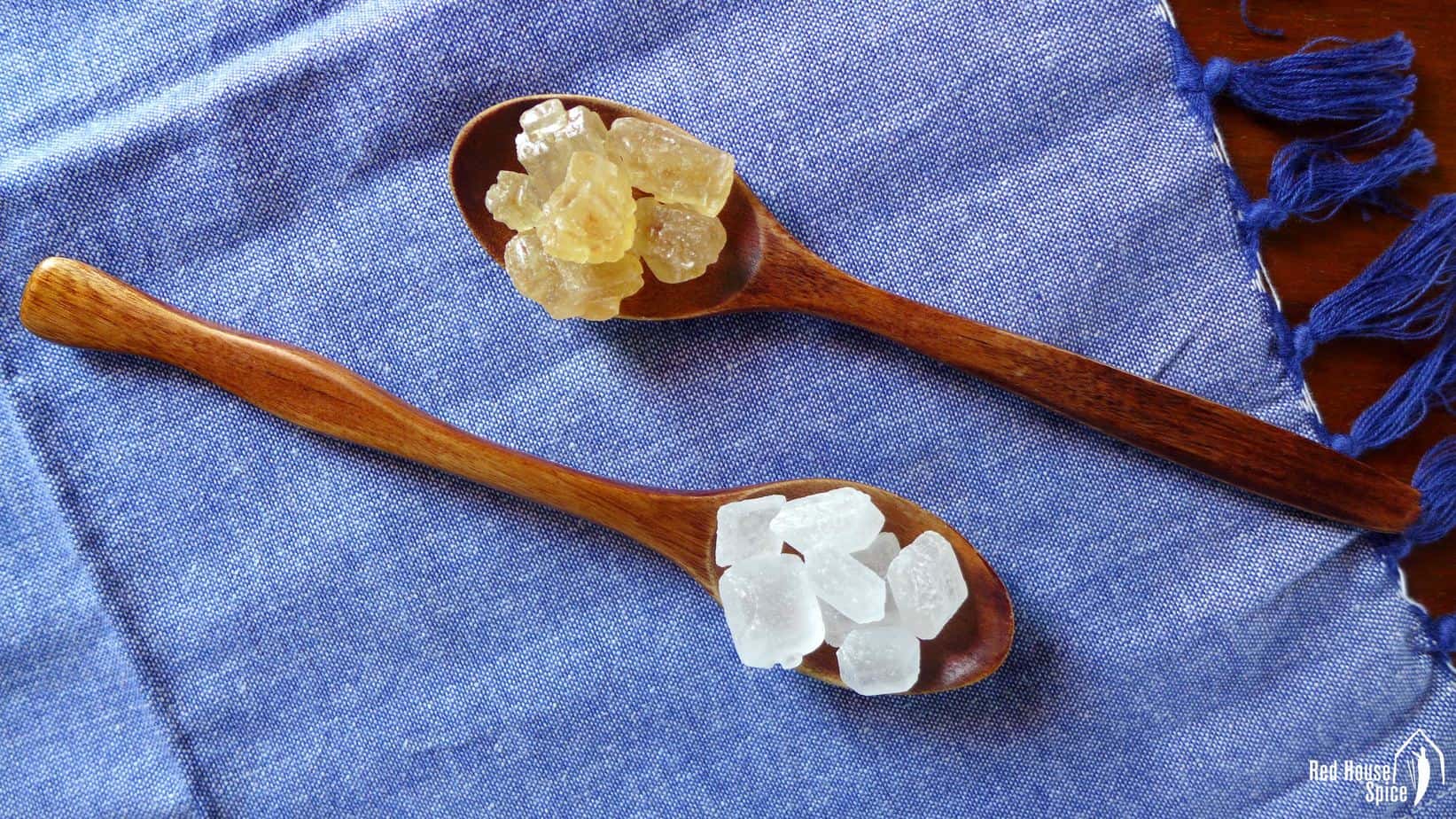
A type of refined, crystallized sugar, Rock sugar is traditionally indispensable in Chinese pantries. Less sweet than white sugar, it’s believed to add shine to braised dishes. However, please feel free to replace it with regular sugar if you wish.
Cooking steps
It does take a while to cook this dish to the desired texture, but the process is simple and hassle-free. Here are the three steps:
Step 1: Blanch the pork
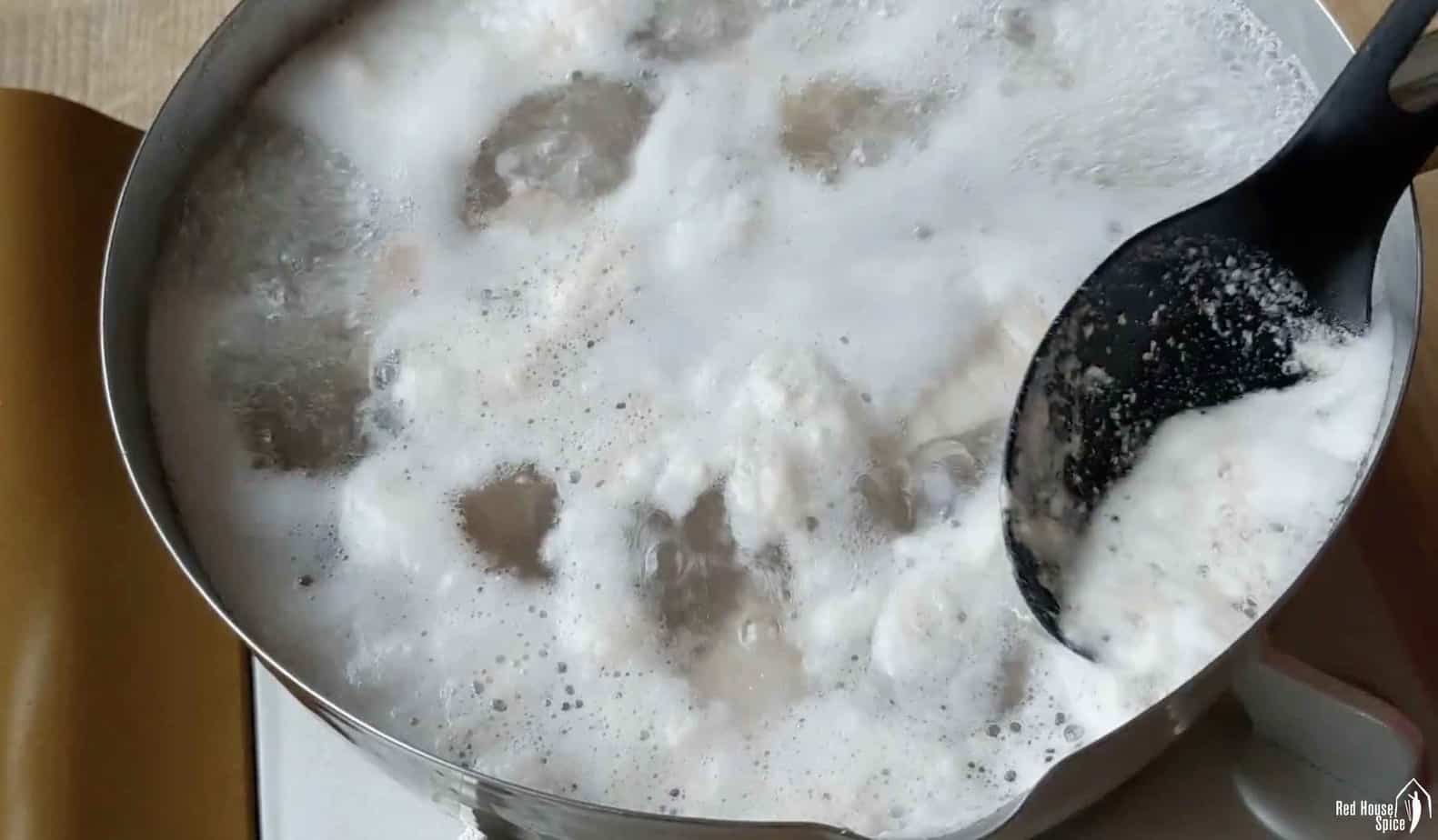
Blanching is a required procedure when cooking Chinese-style braised meat. It’s for removing blood and other impurities from the muscles and bones thus achieving a less cloudy broth and a less gamey taste.
Put the pork belly cubes into a pot filled with cold water then turn on the heat to high. As soon as it starts boiling, you’ll see froth appearing on the surface. Use a spoon to remove most of it. Then drain and rinse the meat under running water.
Step 2: Braise the pork
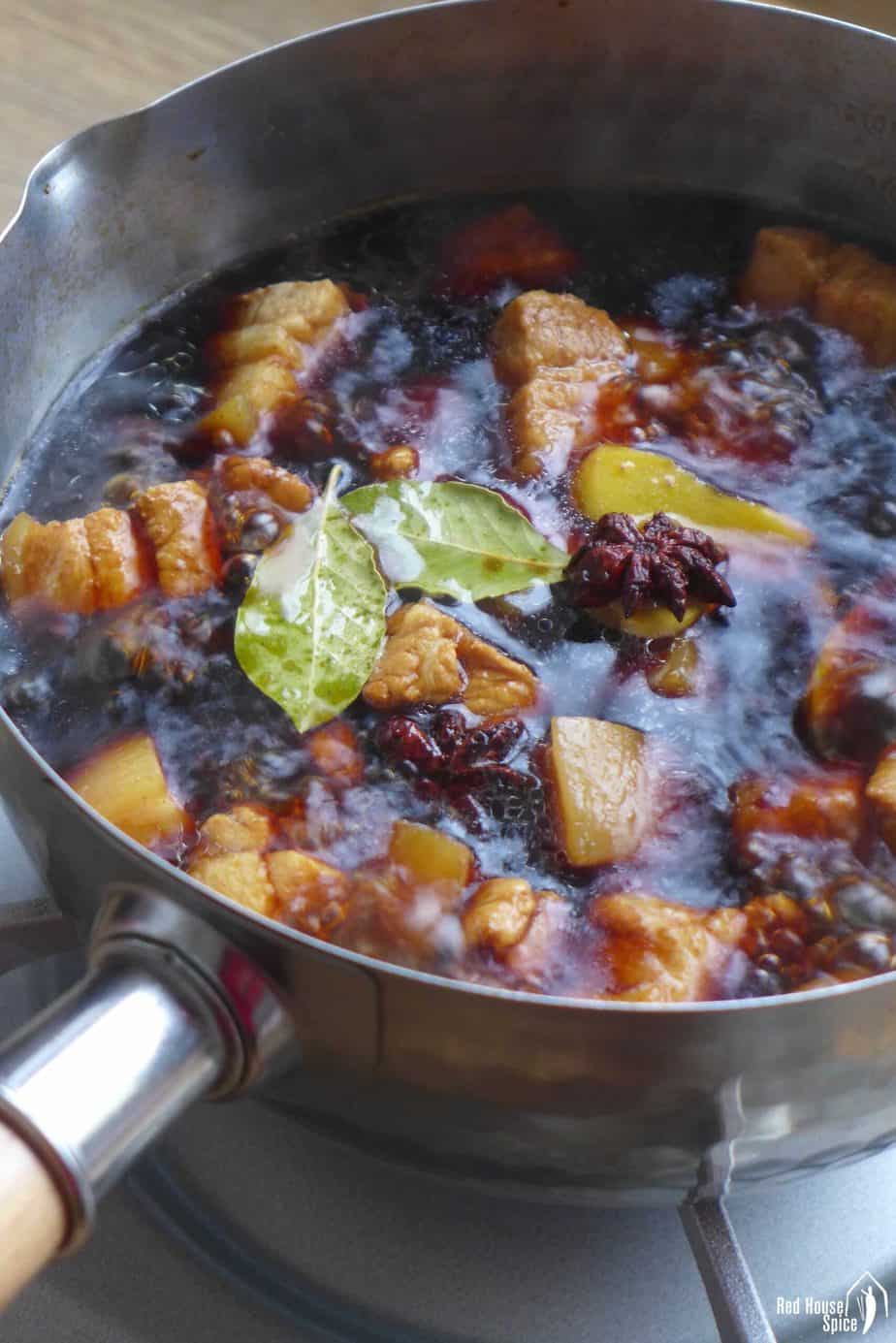
After blanching, put the pork into a clean pot then pour in Shaoxing rice wine and hot water (barely cover the meat). Add light soy sauce, dark soy sauce, ginger, star anise and bay leaves.
Turn on the heat to bring the liquid to a full boil. Cover with a lid and turn down the heat. Leave to simmer for at least one hour. Poke one piece of meat with a chopstick to check the tenderness. If it goes through without much resistance, you’re ready to move onto the next step.
During this process, remember to stir around the meat 1-2 times. If you notice the liquid becomes too little, add a small amount of hot water to prevent burning (but no need to reach the original volume).
Step 3: Thicken the broth
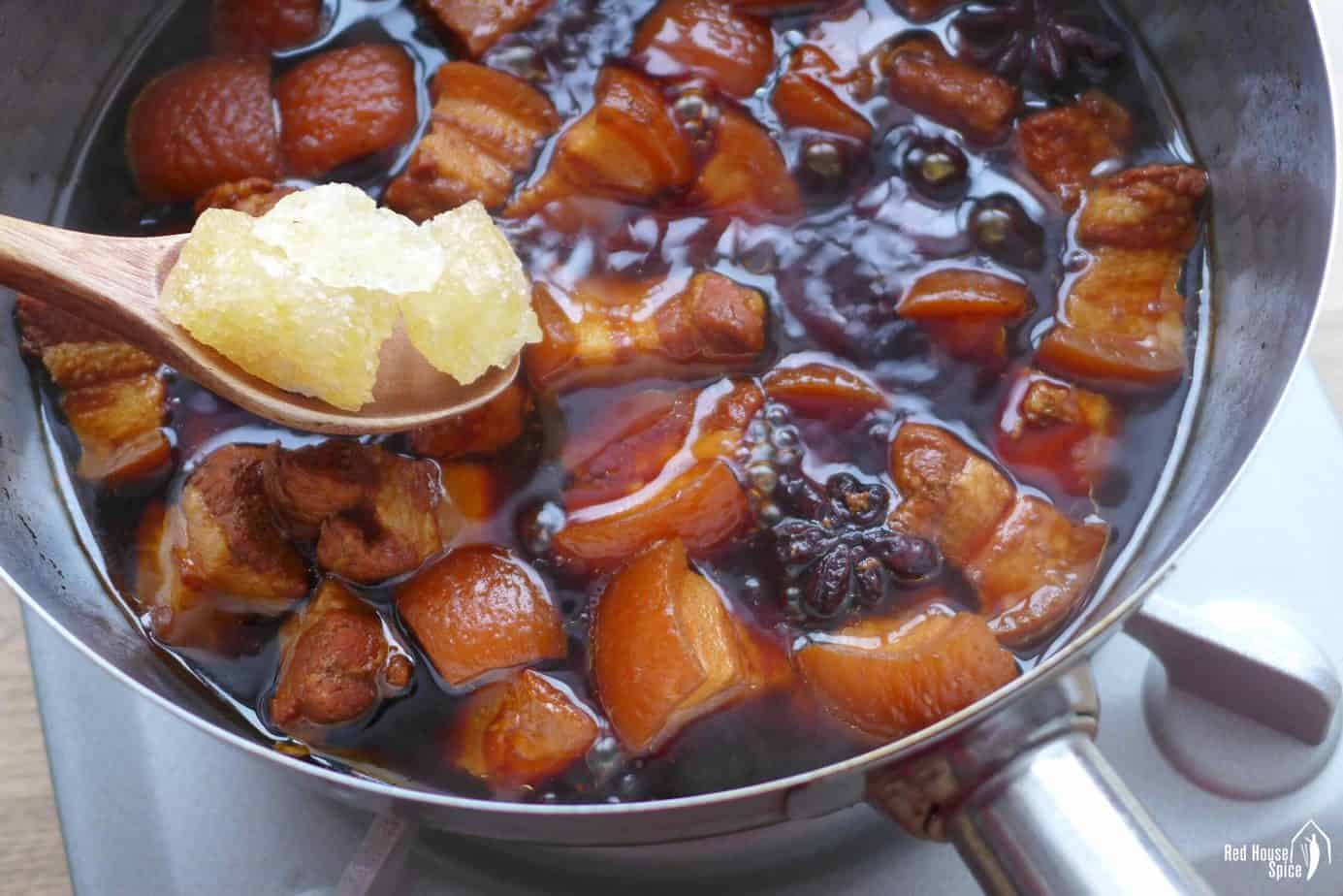
Turn the heat up to the highest. Add rock sugar (or regular white sugar) to the braising liquid and leave to boil fiercely. As the sugar melts and the water evaporates, the broth will dramatically reduce its volume and become thicker.
During this process, stir the pork cubes from time to time to ensure each piece gains an appetising colour and shine. Remove from the heat when the broth is just enough to cover the bottom of the pot (Over-boiling can burn the sauce). Please refer to the tutorial video in the recipe card below.
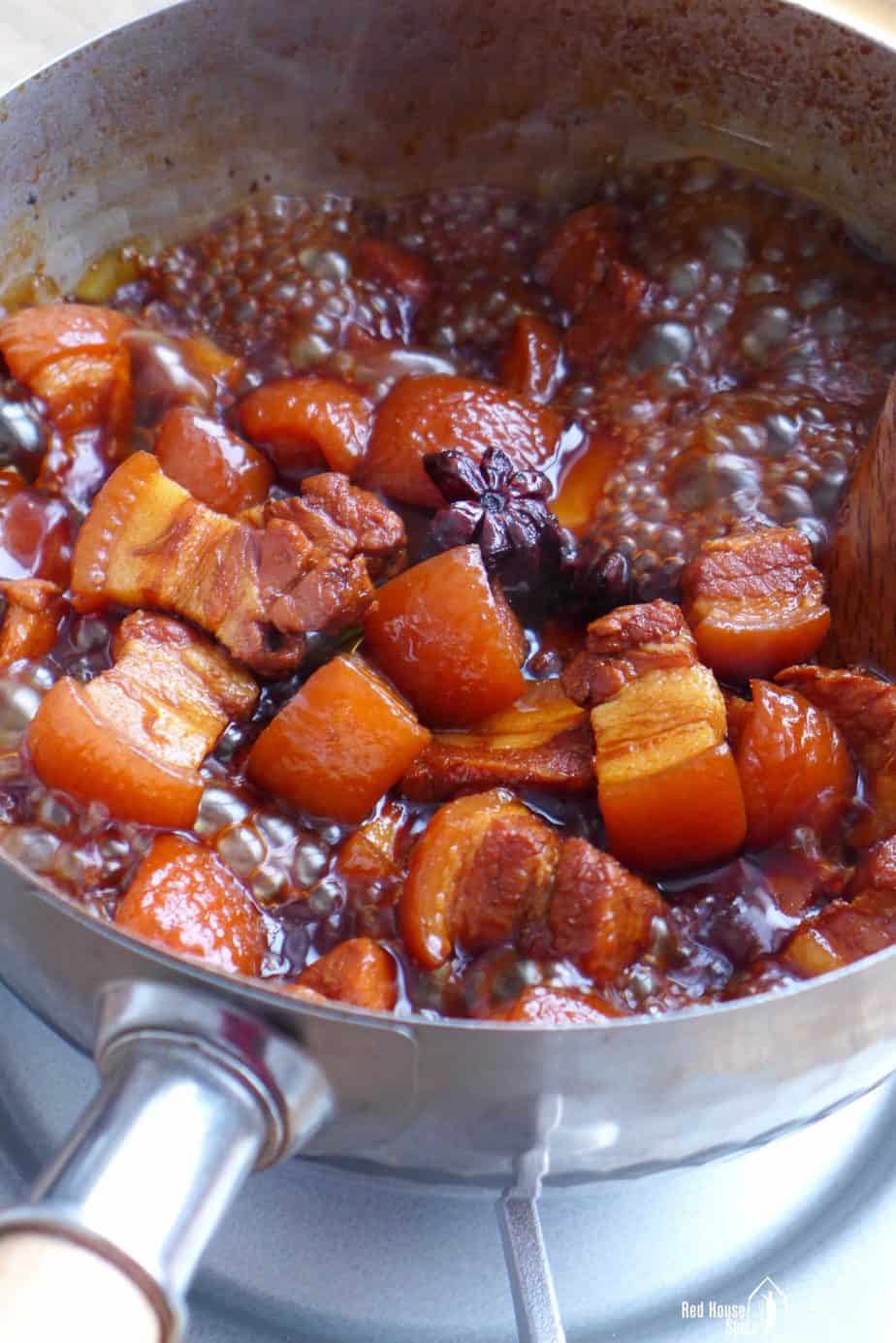
A note about the cookware: If possible, use a small-sized pot so you wouldn’t need too much water to braise the meat making the final thickening process shorter.
How to serve
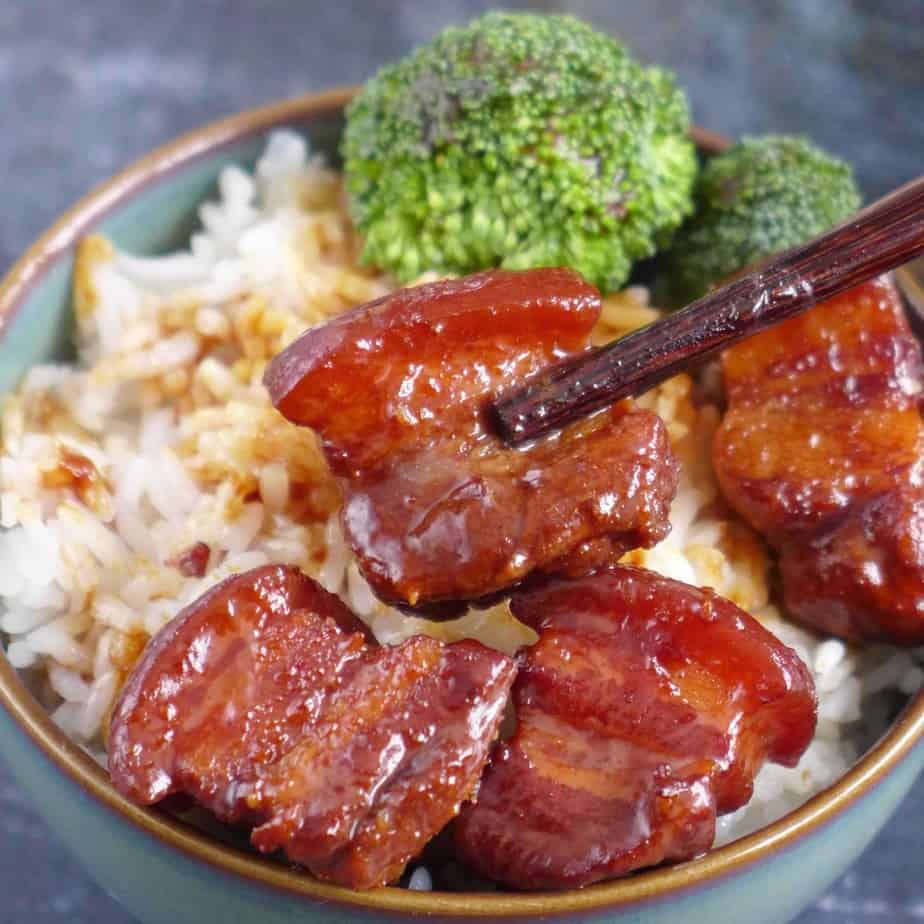
- Most commonly, Chinese red braised pork belly is served as a centrepiece in multi-course sharing meals.
- For a simply all-in-one meal, use it as topping for plain steamed rice, along with blanched vegetables, such as broccoli, bok choy, etc.
- It also makes a wonderful filling for Bing (Chinese pan-baked flatbread) or Gua Bao (half-circle shaped steamed buns).
Recipe FAQs
A: You can freeze it and use it as a master stock for the next time when you cook this dish again (add less seasonings in this case).
A: If used in small quantity, Shaoxing wine can be replace by dry sherry. However, for this recipe I suggest you skip it altogether and increase the water volume. The taste will be different but still nice nevertheless.
A: Yes, you can. Blanch the meat as usual then braise it in your instant pot. You may slightly reduce the hot water. Set to cook 25 minutes on high pressure and perform a natural release. Afterwards, use the sauté function to boil down the broth.
Other pork dishes
Looking for more ideas for pork dishes? Here are some popular recipes:
📋 Recipes
Love this recipe? Please leave a 5-star 🌟🌟🌟🌟🌟 rating in the recipe card below & if you REALLY like it, consider leaving a comment as well!
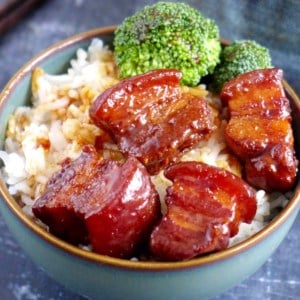
Braised Pork Belly (Hong Shao Rou/红烧肉), an Easy Version
Ingredients
- 600 g pork belly - about 1.3lb
- 250 ml Shaoxing rice wine - about 1 cup, see note 1
- 2 tablespoon light soy sauce
- 1 tablespoon dark soy sauce - see note 2
- 5 slices ginger
- 2 star-anise
- 2 bay leaf
- 20 g rock sugar - or 1 tablespoon regular sugar
Instructions
Blanch the pork
- Cut pork belly into 2-3 cm chunks (about 1 inch). Put into a pot then fill with cold water. Boil over high heat.
- Once it starts boiling, you’ll see froth appearing on the surface. Skim it off with a spoon.
- Drain the meat in a colander then rinse under running water.
Braise the pork
- Put the pork into a clean pot (ideally, a small one, see note 3). Pour in Shaoxing rice wine and hot water (barely covering the meat). Add light soy sauce, dark soy sauce, ginger, star anise and bay leaves.
- Bring the liquid to a full boil. Cover with a lid and leave to simmer over low heat for 1-1.5 hour until the meat is fork-tender (During the process stir the meat around a few times).
Thicken the broth
- Uncover the pot. Add sugar then turn the heat to the highest. Leave to boil fiercely (Stir from time to time) until the broth reduces to just enough to cover the bottom of the pot.
- Serve immediately with plain steamed rice and vegetable dishes of your choice.
Store and reheat
- The cooked pork belly can be stored in the fridge for up to three days or in the freezer for 2 months.
- Reheat in a pot (defrost first if frozen) over low heat. Add a little water to help to heat the pork thoroughly.
Video
NOTES
NUTRITION
NUTRITION DISCLOSURE: Nutritional information on this website is provided as a courtesy to readers. It should be considered estimates. Please use your own brand nutritional values or your preferred nutrition calculator to double check against our estimates.


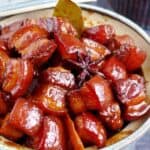
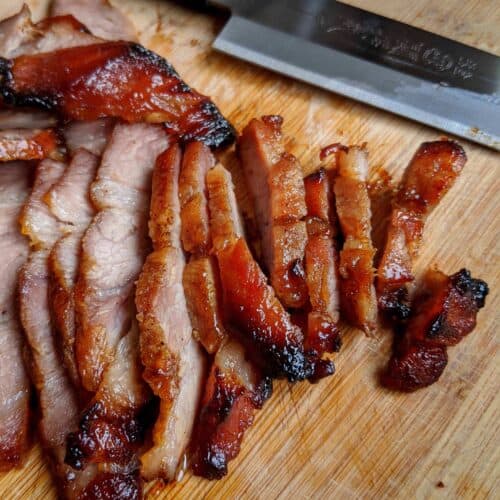
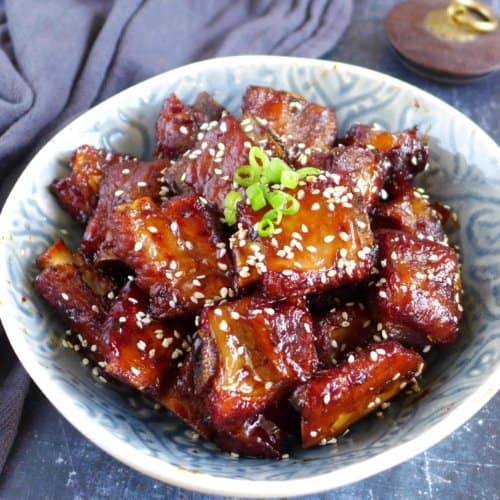
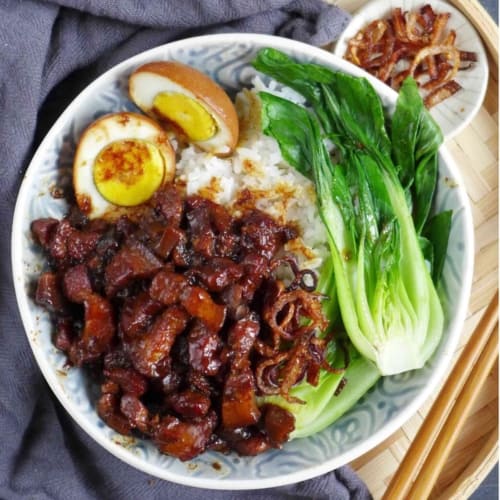
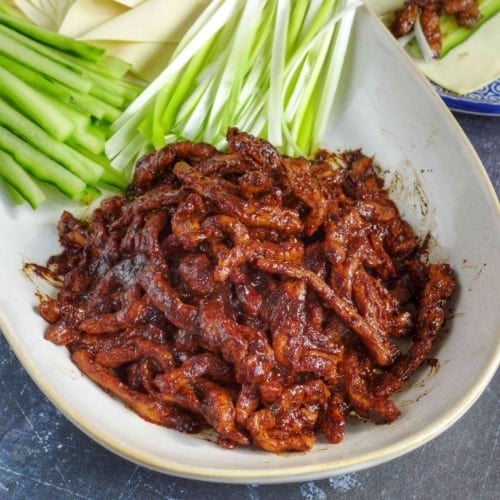

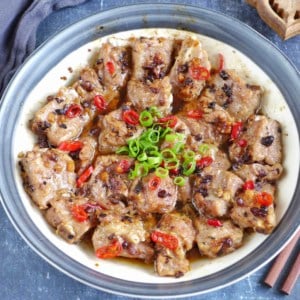
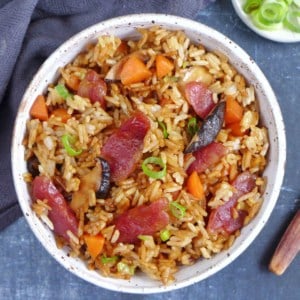
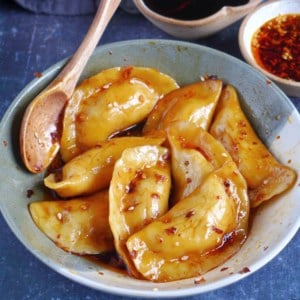
Another great recipe! Truly authentic, easy to follow, and always delicious 🙂
It’s such a classic, right? Happy to know you enjoyed it.
There was a second family dinner a couple of nights later.
Paired with Ginger Chicken, a medley of green vegetables and steamed white rice: Braised pork belly. For the first time I did add red food colouring! And did reduce the cooking sauce as required.
Not a morsel remained!
This classic dish seldom fails to impress, right?
Love this recipe! do you have any suggestions for what to do with the remaining sauce? seems wasteful to throw away such a beautiful sauce.
You can freeze it and use it as a master stock for the next time when you cook this dish again (add less seasonings in this case).
Another excellent recipe. Thanks heaps. Neil
Thanks for the positive feedback!
Wei. This is becoming one of my go-to recipes! When I have the time to cook it.
It is spectacular!
I will keeping cooking it!
Thanks for the positive feedback!
Wei
I cooked the braised pork belly last night. It was superb despite the level of sodium listed on the back of the Shaoxing wine bottle! I will look at that label for the next bottle I purchase!
Served on steamed brown rice with available spring vegetables was a very satisfying meal!
Shaoxing wine is very hard to find where I live, so is there any possible substitute ingredient for it?
Shaoxing rice wine can be replaced by dry sherry if used in small quantity. For this recipe, I’d suggest you skip it altogether if unavailable. Happy cooking!
I cooked this today. It was simply delicious!. Thank you for sharing.
I’m so pleased to have come across your blog. Going thru your recipes brought back a flood of memories of my Mum’s cooking which I miss dearly, especially this one. I remember eating this dish with deep-fried tofu puffs, bean curd sticks and black mushrooms that my Mum would add to it. I look forward to trying out more of your recipes.
Thank you Wei <3
You’re welcome Pauline! Yes, it’s even tastier to add tofu, mushroom, etc. to this dish. So happy to know my recipe reminded you of sweet memories.
I will definitely try this recipe. It looks absolutely delicious!
Happy cooking Natasha!